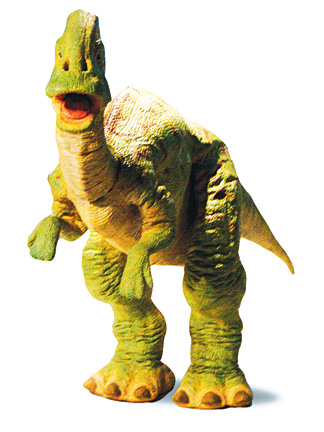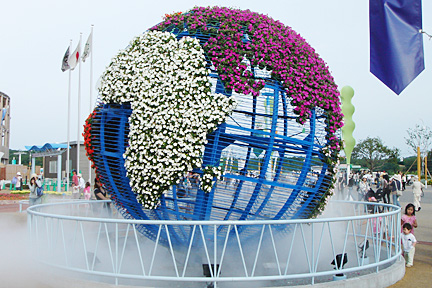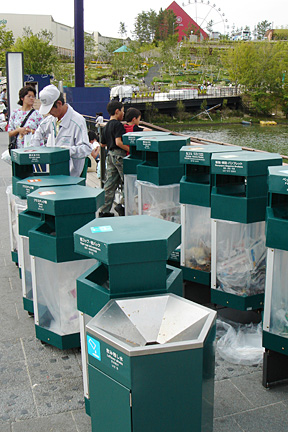 |
Robots roam at
Japan’s Aichi Expo
An ecological theme dominates at an
event that is part technology showcase
and part amusement park
NAGOYA, Japan » Japan has seen the future, and it involves greenery, robots and many different types of trash. Those are the main themes evident at Aichi Expo 2005, the world fair going on through Sept. 25 on the outskirts of Nagoya, Japan's fourth-largest city.
If you go ...What: Aichi Expo 2005Location: 12 miles east of downtown Nagoya, in central Japan Area: 427 acres Duration: Continues through Sept. 25 Attendance: 9.4 million as of late June; 15 million total expected Admission: 4600 yen ($41) adult, 1500 yen ($14) child Web site: www.expo2005.or.jp Hotels: The most convenient (but also most likely to be booked up) are near Nagoya Station, in downtown Nagoya. Kyoto and Osaka hotels are about an hour away by Shinkansen ("bullet train"), cost-effective if you already have a Japan Railways Railpass. Some travel agencies listed on the Expo Web site offer ticket/hotel packages. Getting there: Trains, a subway line and shuttle buses operate from Nagoya Station (about 40 minutes) and Chubu Centrair International Airport (about 70 minutes). Nagoya itself is about 2 hours from Tokyo by Shinkansen. Tips: Download a map from the Web site before you get there to plan what you want to see. There's too much going on to see it all by just wandering. If you want to get into some of the corporate pavilions, get to the Expo site early and go there first thing, or be prepared to wait.
|
But that is appropriate given the overarching slogan of the expo, "Nature's Wisdom."
Japan, with its aging population and heavy-industry legacy, is in many ways a poster child for the dilemma the industrialized world faces: how to build a future that is livable without choking off growth.
To address these issues without getting too preachy, the organizers have created an event that is part technology showcase, part amusement park.
Overall, think of an eco-Disneyland, but with draft beer available.
There are Ferris wheels, a few modest thrill rides and multiple playground areas for the kids. Evenings include live performances by musicians from around the world.
And of course there are gift shops, most offering souvenirs with the expo mascots, Morizo and Kiccoro. The pair of furry green forest sprites will look familiar to anyone who has seen the Hayao Miyazaki animated movie "My Neighbor Totoro" -- indeed, a set from that movie has been replicated at the expo -- but were designed by someone else, two Japanese sisters who work under the name Aranzi Aronzo.
The expo boasts a huge central food court. But more convenient are the snack booths scattered about the venue selling fast food from around Asia -- we snagged some excellent vegetarian manapua and takoyaki -- as well as inevitable theme-park staples like pizza.
Getting close to nature is part of the expo theme, and the site straddles several large stands of forest, but for visitors it is a managed version of nature. A forest walk takes you along a gravel path carefully engineered to be free of bumps, boulders and other irregularities. It makes a refreshing break for rushed city dwellers -- multilingual signs even remind you not to hurry -- but wild it is not.
More serious nods to the expo's ecological theme abound, however, from the park's "bio-lung" -- a 450-foot wall planted with greenery, designed for esthetics as well as fresh air -- to the grass-covered rooftops of many of the buildings.

A convoy of hybrid-powered robot buses awaits visitors at Aichi Expo 2005.
Japan has long asked its citizens to sort their trash, but the Aichi Expo takes this to new heights. At each trash disposal area are 10 separate receptacles for such things as PET bottles, other plastic, brochures, other paper and even disposable chopsticks. The trash can arrays even have attendants to make sure visitors know where to pitch what.
Environmental concerns also had a hand in the expo's transit systems. Visitors can ride to the expo in a quiet magnetic-levitation train, and hydrogen-powered buses link the event's two campuses. Convoys of hybrid-powered robot buses take visitors around the main campus, the driver's seats occupied by only a stuffed expo mascot.
Robots are on view in several other expo venues.

A stuffed mascot mans the wheel of one hybrid-powered robot bus.
Closer to the leading edge were the displays on special exhibition at the expo in mid-June, with 65 prototypes by university and other research groups.
Less polished but more edgy than their corporate-designed brethren, the projects range from the serious, like an automated medical wheelchair and assorted search-and-rescue robots, to the almost silly, such as a TV news reporter robot and a small boxing robot. Others were simply a technological tour de force: a tiny robot hand that can play Jan Ken Po with visitors, and a fish-shaped swimming robot.
The expo's robot mastery did not extend to the automated ticketing system, which was supposed to offer same-day advance tickets to the pavilions' shows in a manner similar to Disney's Fastpass. Advance ticket booths were offline for the pavilions we tried, making long lines the only alternative. Waits for the most popular pavilions were in the 60-minute range during our two days there.
The expo set aside 20 percent of pavilion tickets for reservations via the Internet, but we found that option impractical.
Often, you do not know if you will have the energy or inclination to visit a given pavilion until you are there.
Fortunately, there is enough going on for visitors to have a good time without the pavilion shows and perhaps learn something as well.
One of the lessons should be on the limits of so-called green technologies. For example, despite all of its eco-tech prowess, the expo itself is not self-sufficient in energy.
But world fairs have always been about visions of the future, not immediate, buy-it-tomorrow solutions. And for once these visions are of a future that is sustainable.
And in that respect, Aichi Expo 2005 is a breath of fresh air.

A robot television news reporter interviews a technician at the expo.


A dinosaur robot performs at the children's Wanpaku Treasure Island Robot Station.

A flower-covered globe near the entrance helps set the theme of Aichi Expo 2005. Mist generators at the base help visitors keep cool in Nagoya's summer heat.

Trash-can arrays like these ask visitors to sort their trash before disposal.
www.expo2005.or.jp
E-mail to Travel Desk
[News] [Business] [Features] [Sports] [Editorial] [Do It Electric!]
[Classified Ads] [Search] [Subscribe] [Info] [Letter to Editor]
[Feedback]
